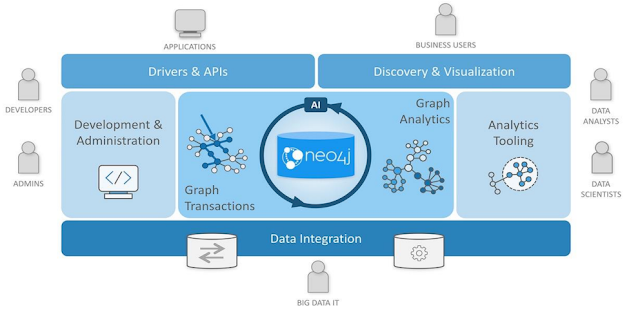NEO4J Graph Platform
The Neo4j Graph Platform is a comprehensive set of tools, services, and capabilities provided by Neo4j to build and deploy graph-based applications. It includes the Neo4j graph database, along with additional components that enhance the development and deployment experience.
The key components of the Neo4j Graph Platform are:
- Neo4j Database:
- The core component of the platform is the Neo4j graph database, which is a high-performance, scalable, and ACID-compliant graph database management system.
- It provides the foundation for storing, managing, and querying highly connected data using the power of graph data models.
- Cypher Query Language:
- Neo4j's Cypher query language is a key part of the platform.
- It is a declarative language specifically designed for querying and manipulating graph data.
- Cypher provides a concise and expressive syntax to work with nodes, relationships, and graph patterns, allowing developers to easily retrieve and modify data.
- Neo4j Browser:
- The Neo4j Browser is a web-based development tool that comes bundled with the Neo4j Graph Platform.
- It provides an interactive interface for executing Cypher queries, visualizing graph data, and exploring the database.
- The Browser offers a user-friendly environment for working with Neo4j and understanding the structure and content of the graph.
- Neo4j Desktop:
- Neo4j Desktop is a desktop application that simplifies the local development and management of Neo4j databases.
- It provides a graphical interface to create, manage, and deploy multiple Neo4j instances, as well as tools for designing graph models, executing queries, and monitoring database performance.
- Neo4j Aura:
- Neo4j Aura is a fully managed graph database service offered by Neo4j.
- It provides a cloud-based deployment option for running Neo4j databases without the need for infrastructure management.
- With Aura, you can easily deploy and scale your graph databases in the cloud, while benefiting from automated maintenance, backups, and high availability.
- Neo4j Bloom:
- Neo4j Bloom is a visualization and exploration tool that allows users to visually navigate and analyze graph data.
- It provides an intuitive interface for non-technical users to interact with graphs, discover patterns, and gain insights. Bloom enables business users to explore graph data without writing queries or code.
- Neo4j Graph Data Science:
- Neo4j Graph Data Science is a library and toolkit for performing advanced graph analytics and data science tasks on Neo4j databases.
- It includes a collection of algorithms and functions optimized for graph data, enabling users to uncover patterns, detect anomalies, perform machine learning, and gain deeper insights from their graph data.
These components together form the Neo4j Graph Platform, providing a comprehensive and integrated solution for developing, managing, and analyzing graph-based applications. Whether you are building social networks, recommendation engines, fraud detection systems, or knowledge graphs, the Neo4j Graph Platform offers the necessary tools and capabilities to leverage the power of connected data.
Graph Data Modelling
- Graph data modeling is the process in which a user describes an arbitrary domain as a connected graph of nodes and relationships with properties and labels.
- A Neo4j graph data model is designed to answer questions in the form of Cypher queries and solve business and technical problems by organizing a data structure for the graph database.
- The graph data model is often referred to as being "whiteboard-friendly". Typically, when designing a data model, people draw example data on the whiteboard and connect it to other data drawn to show how different items connect.
- The whiteboard model is then re-formatted and structured to fit normalized tables for a relational model.
- A similar process exists in graph data modeling, as well. However, instead of modifying the data model to fit a normalized table structure, the graph data model stays exactly as it was drawn on the whiteboard.
- This is where the graph data model gets its name for being "whiteboard-friendly".

No comments:
Write commentsPlease do not enter spam links